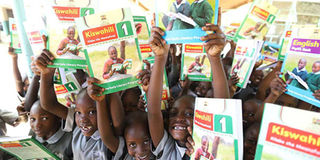Ministry on the spot as suppliers flood schools with books

Kenya Literature Bureau distributes textbooks to Central Primary School pupils in Kisumu on January 9, 2019. PHOTO | FILE | NATION MEDIA GROUP
What you need to know:
- The greatest beneficiaries of the industry that runs into billions of shillings appear to be publishers, who since 2017 have been contracted to supply books directly to schools.
- The Kenya Secondary School Heads Association has proposed that the distribution exercise be suspended for four years in order to allow schools to utilise the available books.
- Kuppet chairman Omboko Milemba said the government was dumping textbooks in schools to create a market and money for suppliers.
A major racket has hit the government’s textbook supply project started last year to improve the quality of teaching and learning.
The Education ministry, which is managing the project, has saturated schools with excess books in a scheme that appears aimed at profiteering suppliers.
Investigations by the Nation reveal that some schools have been supplied with nearly double the number of textbooks they need, in virtually all subjects.
The textbook supply policy replaced an equally corruption-prone system where schools bought books from booksellers and publishers based on recommendations of the Kenya Institute of Curriculum Development (KICD), contained in what was known as the Orange Book.
Last year, the government decided it would procure books directly from publishers and supply schools, with the aim of making savings from discounts on account of bulk purchases.
CORRUPTION
The government announced that the new system would save taxpayers large sums of money.
The cost of textbooks for secondary schools would drop from Sh21 billion to Sh7.5 billion a year, it said.
However, the project seems to have opened a route for corruption and deal-making. Books are bought in unnecessarily large quantities to allow for profiteering and kickbacks, at the expense of the taxpayer.
According to a Nation survey, a number of schools have an oversupply of textbooks and are even struggling to store them.
One school received 4,135 books instead of the 2,781 it needed to give each student a copy of all the recommended books.
DONORS
The greatest beneficiaries of the industry that runs into billions of shillings appear to be publishers, who since 2017 have been contracted to supply books directly to schools after the exercise was taken away from headteachers over allegations of corruption.
In addition to the government's allocation of Sh7.5 billion for textbooks, donors have pumped in close to Sh13 billion, mostly for primary education.
There is a Sh5 billion Tusome Project that seeks to improve learning outcomes for classes One and Two in Kiswahili and English.
There is also an Sh8.8 billion programme funded by the Global Partnership for Education (GPE) under the supervision of the World Bank.
Under the project, some 4,000 schools have been put on a School Improvement Project (SIP) to boost their Kenya Certificate of Primary Education (KCPE) performance after they recorded a mean of 243 marks.
GLUT SOLUTION
The Kenya Secondary School Heads Association (Kessha) has proposed that the distribution exercise be suspended for four years in order to allow schools to utilise the available books.
Already the Ethics and Anti-Corruption Commission (EACC) is probing allegations of irregularities in procurement of textbooks for State-sponsored schools under the Free Primary Education Fund, estimated at Sh10 billion.
“Schools have already achieved the 1:1 ratio per subject and do not need textbooks for the next four years, which is the shelf life of a book,” Kessha chairman Kahi Indimuli said in a proposal to the Ministry of Education.
He said the government has shifted buying of Kiswahili and English set books and mathematical tables from parents to schools without any additional funding, a further drain on the already constrained vote.
REVISION
Kenya Union of Post-Primary Education Teachers (Kuppet) chairman Omboko Milemba said the government was dumping textbooks in schools to create a market and money for suppliers.
“A school with 100 students is getting between 150 and 250 books for the same subject every year. Schools that don’t offer optional subjects like home science, power mechanics are now receiving such books, benefiting suppliers at the expense of the taxpayer,” Mr Milemba said.
He questioned the supply of excess books when schools need basic infrastructure like classes, laboratories and stores more.
“It is common knowledge that schools are experiencing acute teacher shortages and most of them employ BOM teachers. It is through the government accounts that BOM teachers and school workers are paid,” Mr Indimuli observed.
He said the textbook recovery programme is excessive and has handicapped teaching and learning needs in other vote heads.
ICT LEARNING
Increasing the amount for the tuition vote head through inter-borrowing from other equally needy vote heads only worsens the challenges being experienced, he said.
The government allocates Sh4,196.68 per student for textbooks.
“Our proposal is that the current allocation on textbooks be increased to fund ICT integration in teaching and learning, technical subjects and fully equipping our laboratories,” he added.
The National Parents Association chairman, Mr Nicholas Maiyo, called for transparency in the procurement of books.
“We want to see value for money and books should not be dumped in schools,” he said.
However, Kenya Publishers Association (KPA) chairman Lawrence Njagi said the textbook supply policy is aimed at ensuring all students have books.
“We want to ensure that a student in Form Four has all textbooks from Form One that he or she can use for revision.”
SUPPLY
The Ministry of Education officials could not be reached for comment.
Last month the ministry disclosed that it had distributed 32 million textbooks to primary and secondary schools in the past one year.
Its report indicated that textbooks for four subjects in primary and six subjects in secondary schools were distributed to learning institutions in all the counties.
That data indicated that 31 million textbooks have been given to learners, and 579,408 primary teachers guides and 310,464 secondary teachers guides issued to tutors.




